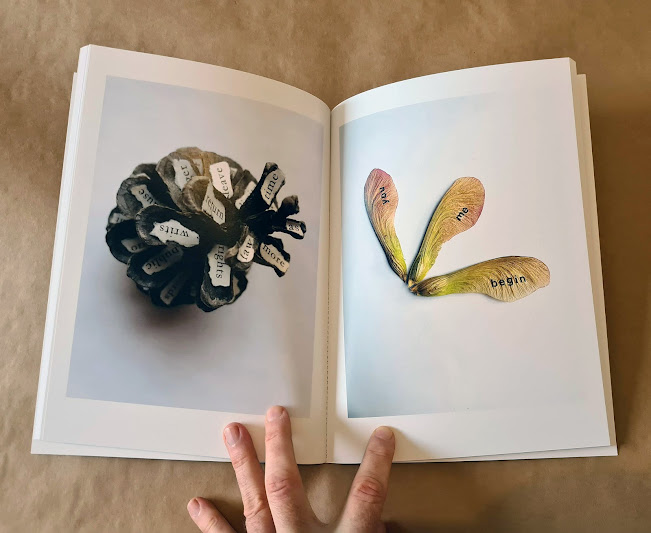Comprised of seventy-three large full-colour photographs of visual poems comprised of a combination of object (leaf, bark, branch) and text, is Toronto poet, editor and publisher Kate Siklosi’s full-length debut, leavings (Malmö, Sweden: Timglaset Editions, 2021). leavings is a collection of visual pieces composed through a combination of printed text, visual poems and letraset combined with leaves, twigs, branches and fir to reveal, in close detail, the physical interactions between nature and language, and the impact of absolute brevity. In her piece “Hot and Bothered: Or, How I Fell In and Out of Love With Poetic Conceptualism” at The Puritan (posted May 1, 2017), she writes on “the trajectory of my personal love affair with conceptualism” through looking at M. NourbeSe Philip’s Zong! (The Mercury Press, 2008) [see my review of such here] and Jordan Abel’s Un/Inhabited (2014) [see my review of such here] and Injun (2015) [see my review of such here], writing that “Sure, in some sense, it is ‘enough’ to screw around with language and create art that floats inside a beautiful ether. But in the face of the continuing projects of settler colonialism—to which we are all subject, to lesser or greater degrees—I could no longer ignore the ways in which authors consciously use and abuse poetic material in their work.” Through such, she writes of both the requirements of properly acknowledging the materials with which she works, as well as a deeper purpose than simply messing about with language. As she writes: “in revealing the (mis)use and arbitrariness of language, and of his-tory writ large, social activism and aesthetic praxis are fused. Their poetic labour combines conceptualism’s interrogations of language and symbolic representation with a persistent concern for equity and social justice.” She writes of, as her endquote by bill bissett offers, a “shared fragility,” as well as a particular kind of interconnectedness. One side of her work could not exist at all without the other.
The pieces are structured in four titled sections, with a single large image per page: the twenty works of “a leaf,” the twenty-three pieces of “a leave,” the eleven pieces of “a left,” and the nineteen pieces of “a mend.” By section titles alone, Siklosi’s quartet hints at an echo of bpNichol’s infamous eight-line poem etched into the concrete of the Toronto lane that now shares his name: “A / LAKE / A / LINE / A / LONE [.]” Just as in Nichol’s poem set in concrete, Siklosi’s poems are uniquely physical, and deliberately temporal; the delicate nature of some of these pieces suggest that most, if not all, might no longer exist in the forms shown in the photographs, leaving the photograph as both framing and document of an object that can’t easily, or ever, be archived. Is her purpose, then, through the exploration, the object or the documentation? There is something fascinating in the way the pieces in leavings also suggest an approach in tandem with her found materials. These pieces exist, one might say, in collaboration between Siklosi and her materials (leaves, branches, etcetera), as opposed to her simply dismantling and repurposing whatever materials she may have found as part of her walks (her acknowledgments include a “Thank you to NourbeSe for our ravine walks, on which many of these leaves and thoughts were collected.”). Instead, Siklosi appears to respond, from her collaborative corner, as a way of shaping to and around the materials-at-hand. It is no accident, I would think, that her dedication reads, simply: “for the land, our wisest poet [.]” As she writes to preface the collection:
a life is composed of leavings: the remains of crusts and skins, the remnants of night in a dawn sky, the residue of mourning, loves too deep and too shallow, the hard words left unsaid, the time taken, the dust in our tracks. in our tiny expanse, things pass and things grow. we kill and we cultivate. we hurt and we mend. we pick up the pieces and create. we do better and we fail. we thread ragged beginnings from the trodden decay of our pasts. beginnings still. we collect, windswept and tired, in piles against a fence. in our shared fragility, we quilt a being, warm and enough.
Over
the past few years, Timglaset Editions has emerged as one of our most important,
and even most visible, publishers of concrete and visual poetry, producing
numerous bits of ephemera along more substantial trade editions, including Amanda
Earl’s landmark anthology Judith: Women Making Visual Poetry (2020) [see my review of such here], a book that Siklosi’s work was also included in, and
this book is stunning for the delicate care clearly evidenced through productions.
After seeing Siklosi’s work for so long in smaller publications, such as her
wealth of chapbooks and pamphlets over the past few years—po po poems (Ottawa ON: above/ground press, 2018), may day (Calgary AB: № Press,
2018), coup (Calgary AB: The Blasted Tree, 2018), fragile
armies (England: Penteract Press, 2018), 1956 (above/ground press, 2019),
She Bites (Wilmington, NC: Happy Monks Press, 2019) and 6 feuilles
(Toronto ON: nOIR:Z 2019)—it is interesting to see her work stretch itself across
such a larger and broader canvas. Given she has a further collection
forthcoming in 2023 with Invisible Publishing, a manuscript combining text and
image, one can only imagine this as simply our introduction as readers to a
range of thinking that she has been engaged with for some time, merely hinted at
through all she has published so far.




No comments:
Post a Comment